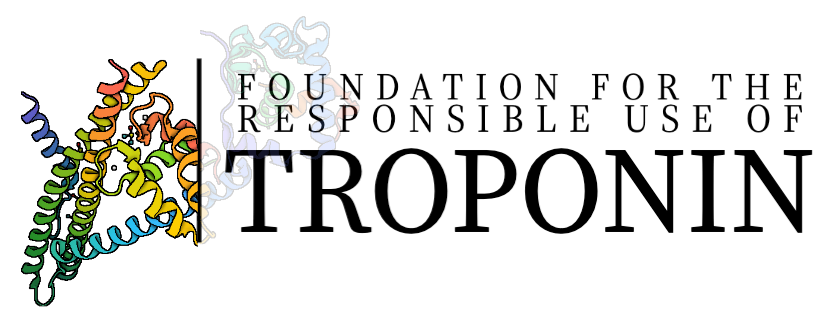1st Generation
The first diagnostic assays for detecting Tn in serum were developed in the 1980s using radioimmunoassay technology (Figure 3). Prior to this, diagnosis of myocardial injury relied on markers such as creatine kinase-MB (CK-MB) and lactate dehydrogen-ase-1 and -2 (LDH-1/2). However, the expression of CK-MB and LDH is not unique to cardiac muscle, leading to diagnostic uncertainty. TnI was chosen for the first generation of Tn assays because its expression is limited to the myocardium. For this assay, antisera to cardiac TnI were raised in rabbits and sheep, serum samples were iodinated with [125I], and after precipitation of the antibody-TnI complex with an anti-rabbit or anti-sheep antibody, radioactivity was measured on a gamma counter. The entire procedure took between two and four days. The lower limit of detection was approximately 10 ng/mL, and the operating range was 10–1000 ng/mL. Cross-reactivity between cardiac and skeletal muscle proteins was estimated at <2% [54]. In an early study of 32 patients with acute MI, a 10–12-fold increase above normal TnI levels was detected, with a mean of 112 ng/mL (range 20–550 ng/mL), peaking between 15 and 24 h after MI [54].
2nd Generation
The second generation of Tn assays had a level of detection that was an order of magnitude better than first-generation assays (~1.5 ng/mL) [55]. An important change was the introduction of direct enzyme-linked immunoassay (ELISA) technology in place of a radio-isotopic readout (Status E100 spectrophotometer, Kallestad Laboratories, Inc., Cheska, MN, USA). Measurements of TnI levels in sera were made using an optical readout of visible-light absorbance, which not only avoided exposure from the radioactive [125I]-labeling, but also afforded higher sensitivity, as the enzyme was able to amplify the signal from a minimal amount of Tn antigen [62]. Moreover, some second-generation assays began to use two Tn-specific antibodies to improve specificity and sensitivity. A typical second-generation assay, using ELISA technology, had a range from 0.2–20 μg/L and within-run coefficient of variation of 4.7%. In a notable improvement from first-generation assays, second-generation assays could be performed within 30 min and displayed no cross-reactivity with skeletal muscle [63]. A limitation of most sec-ond-generation TnT assays was that the calibration was performed with bovine TnT standards, which resulted in curves that were not always linear [64]. However, this lim-itation was addressed in third-generation Tn assays, described below.
3rd Generation
Continued improvement in detection technology, including the Roche Elecsys 2010 immunology analyzer (Roche Diagnostics Corporation, Indianapolis, IN, USA), brought further improvements in sensitivity to third-generation assays. Crucially, this generation also adopted human Tn standards for calibration, eliminating previous issues with non-linearity encountered with bovine Tn standard use. For a typical third-generation TnT assay, the analytical range was approximately 0.01–25 μg/L, with 10% CoV at 0.03 μg/L. The URI, which represents the 99th percentile of a population of healthy controls, was below the lower LoD. In a typical laboratory setting, intra-assay and inter-assay CoVs were 7.9% and 11.2%, respectively [64]. As a result of the improved sensitivity, in a study of 750 patients admitted to a coronary care unit, 35% of additional patients were diagnosed with an acute MI [64]. Furthermore, being more sensitive, the third-generation assay was able to identify a subgroup of patients with minor myocardial injury, who nevertheless were found to have an increased risk of future cardiac events. The ability for mild Tn elevations to carry prognostic significance in subclinical disease would be a feature common to subsequent generations of Tn assays.
4th Generation
Fourth-generation assays continued to improve the sensitivity of Tn measurements compared to their third-generation counterparts. Most continue to use direct chemilu-minescent technology which was introduced in the second-generation assays as described above. Notably, fourth-generation assays use at least two unique antibodies, with some using three antibodies. For example, one fourth-generation assay, the ADVIA Centaur TnI-Ultra, uses one monoclonal and two polyclonal antibodies raised against the central region of TnI, which allows for enhanced binding. When combined with a proprietary blocking reagent that removes nonspecific binding, this technique was able to achieve a [56] manufacturer-stated assay range of 0.006–50 ng/mL; the 99th-percentile value was 0.04 ng/mL and a 10% CoV was obtained at 0.02 ng/mL [56]. Another commonly used fourth-generation assay, the Roche Elecsys TnT Stat (Roche Diagnostics Corporation, Indianapolis, IN, USA), also uses direct sandwich immunoassay technology, but with streptavidin-coated microparticles to enhance the signal. The analytical sensitivity of this fourth-generation test is 0.01 ng/mL, with a concentration of 0.03 ng/mL providing a 10% CoV [65].
Gokhan I, Dong W, Grubman D, Mezue K, Yang D, Wang Y, Gandhi PU, Kwan JM, Hu J-R. Clinical Biochemistry of Serum Troponin. Diagnostics. 2024; 14(4):378. https://doi.org/10.3390/diagnostics14040378

